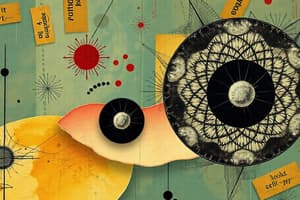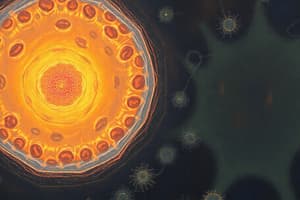Podcast
Questions and Answers
What structure in eukaryotic cells protects and stores the cell's DNA?
What structure in eukaryotic cells protects and stores the cell's DNA?
- Endoplasmic Reticulum
- Golgi Apparatus
- Nucleus (correct)
- Ribosome
Which organelle is responsible for producing ATP through the conversion of glucose?
Which organelle is responsible for producing ATP through the conversion of glucose?
- Nucleus
- Mitochondria (correct)
- Ribosome
- Endoplasmic Reticulum
Which statement about ribosomes is correct?
Which statement about ribosomes is correct?
- They only exist inside the nucleus.
- They store the cell's DNA.
- They are composed solely of smooth ER.
- They link amino acids to form proteins. (correct)
What is the primary function of the Golgi Apparatus?
What is the primary function of the Golgi Apparatus?
What is the role of the smooth endoplasmic reticulum (ER)?
What is the role of the smooth endoplasmic reticulum (ER)?
What is the primary function of lysosomes in cells?
What is the primary function of lysosomes in cells?
Which of the following statements is true about centrioles?
Which of the following statements is true about centrioles?
What do cilia primarily assist with?
What do cilia primarily assist with?
What is the main role of the chloroplast in plant cells?
What is the main role of the chloroplast in plant cells?
How do vacuoles function in plant cells?
How do vacuoles function in plant cells?
Which type of cells require more Golgi apparatus due to their secretion functions?
Which type of cells require more Golgi apparatus due to their secretion functions?
What is the main function of lysosomes within cells?
What is the main function of lysosomes within cells?
Why do white blood cells contain more lysosomes than other cell types?
Why do white blood cells contain more lysosomes than other cell types?
What process do lysosomes assist in for all cells?
What process do lysosomes assist in for all cells?
What occurs when a bacterium is engulfed by a macrophage?
What occurs when a bacterium is engulfed by a macrophage?
Which of the following characteristics is unique to prokaryotic cells?
Which of the following characteristics is unique to prokaryotic cells?
What is a common characteristic shared by both prokaryotic and eukaryotic cells?
What is a common characteristic shared by both prokaryotic and eukaryotic cells?
How do eukaryotic cells primarily reproduce?
How do eukaryotic cells primarily reproduce?
Which of the following statements is true regarding eukaryotic cells?
Which of the following statements is true regarding eukaryotic cells?
What defines the nucleoid region in prokaryotic cells?
What defines the nucleoid region in prokaryotic cells?
Flashcards are hidden until you start studying
Study Notes
Cell Parts
- All cells contain a membrane and cytoplasm.
- All cells consist of a cytoskeleton to support movement.
The Nucleus
- The nucleus is a large, spherical structure that stores and protects the cell's DNA.
- DNA is stored in a long strand called chromatin.
- All eukaryotic cells that divide produce cells with a nucleus.
- Red blood cells don’t have a nucleus to allow room for hemoglobin to bind oxygen.
### The Nucleolus
- Located inside the nucleus.
- DNA is concentrated in the nucleolus.
Ribosomes
- Ribosomes move out of the nucleus to assemble proteins by linking amino acids together through peptide bonds.
- Some float freely in the cytoplasm while others are attached to organelles.
- A large subunit and small subunit make a complete ribosome.
### Endoplasmic Reticulum (ER)
- Flattened sacs that function like a highway.
- Ribosomes can attach to the rough ER.
- It produces proteins and phospholipids for cells.
- The smooth ER is a network of connected tubes without ribosomes.
- It produces cholesterol.
### The Mitochondria
- Located in the cytoplasm.
- Where energy is produced for cells.
- Glucose is converted into chemical energy (ATP) here.
- Cells with high energy demands (muscle, liver, sperm) have a lot of mitochondria.
### Golgi Apparatus
- A system of flat sacs that modify and package proteins.
- Receives material from the ER in spheres called vesicles.
- Vesicles containing protein are "address labeled."
### Vocabulary
- Cytoplasm: where organelles are suspended.
- Chromatin: where DNA is copied to RNA to build proteins.
- Subunit: a smaller component of a molecule, usually a protein molecule.
### Lysosomes
- Contain digestive enzymes to break down polyers so cells can use them for energy production or to create new structures.
- All cells use lysosomes for autolysis, the process of destroying old/damaged cells.
- White blood cells have more lysosomes to destroy pathogens.
- The liver uses them to convert glycogen to glucose.
Cilia
- Hair-like structures on the outside of a cell.
- Assist with movement in unicellular organisms and to move eggs in ovaries.
- Serve as filters in lung cells.
Flagella
- Long, single strands that aid in movement in unicellular organisms or single cells.
- Help to propel sperm cells, bacteria, and protists.
### Centrioles
- Structures made from cytoskeleton pieces that are used during cell division.
- Make fibers that attach and organize chromosomes, letting new cells get the right number.
- Found in animal cells, NOT plant cells.
### Plant Cells
- Have several vacuoles for storage, including a large central vacuole for water storage.
- The main plastid is the chloroplast, containing chlorophyll to capture solar energy.
### Animal Cell
- A diagram of an animal cell is present.
### Vocabulary
- Autolysis: Self breakdown.
- Cytoskeleton: Large network of protein fibers, etc., that gives shape and structure to cells inside the body.
- Vacuole: Membrane-bound organelle in a cell that stores stuff like water and food for cell survival.
### The Golgi Apparatus and Vesicles
- Pancreas cells need a lot of Golgi apparatus because they are a gland that secretes insulin, glucagon, and lipase to other body parts.
- Nerve cells also need a lot of Golgi apparatus because they secrete neurotransmitters—chemicals between other nerve cells.
Lysosomes
- Lysosomes are vesicles that contain digestive enzymes.
- They break down polymers of the four macromolecules so that the cell can use them for energy or to produce new structures.
- White blood cells have more lysosomes so that they can destroy pathogens, and the liver uses them to convert glycogen to glucose.
- All cells use lysosomes for the process of autolysis ("self breakdown") to destroy old or damaged cells.
Prokaryotic vs. Eukaryotic Venn Diagram
- This diagram compares two types of cells: prokaryotic and eukaryotic.
### Prokaryotic Cells
- Characteristics:
- Archea and Eubacteria.
- Doesn't have a nucleus.
- Lacks membrane-bound organelles.
- Has a cell wall.
- Has cytoplasm.
- Reproduces by binary fission.
- Smaller in size.
- Has a nucleoid region.
### Eukaryotic Cells
- Characteristics:
- Protists, plants, animals, fungi.
- Has DNA.
- Has ribosomes.
- Has a nucleus.
- Has a cell/plasma membrane.
- Has membrane-bound organelles.
- Has cytoplasm.
- Uses mitosis to make new cells.
- Can have a nucleus.
- Larger in size.
### Overlapping Characteristics
- Has DNA
- Has ribosomes
- Has cytoplasm
Studying That Suits You
Use AI to generate personalized quizzes and flashcards to suit your learning preferences.




